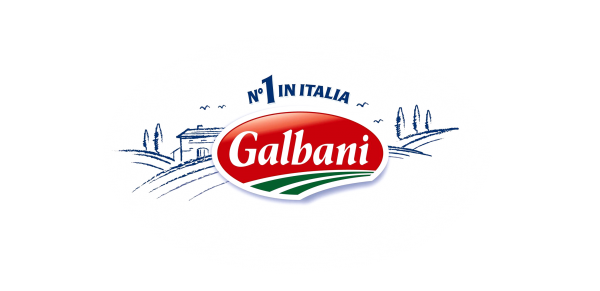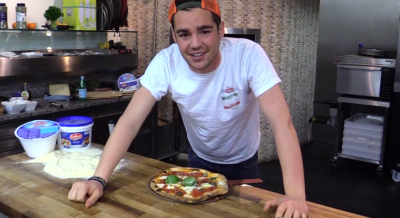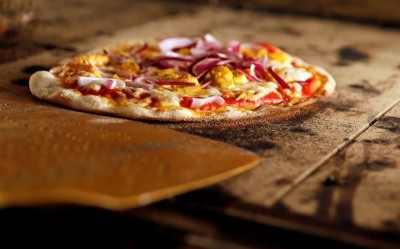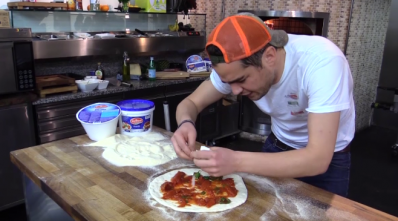Content sponsored by the authentic Italian cheese firm Galbani.
Sponsored - How pizza can boost your pub’s food sales
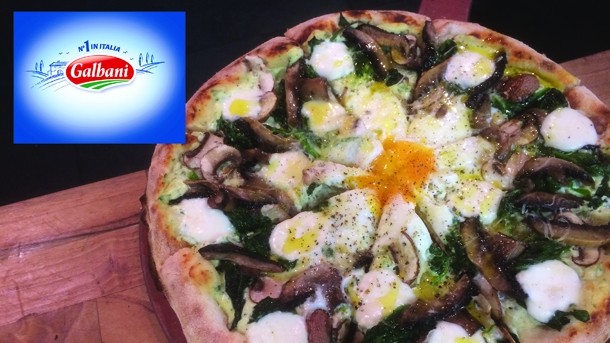
Pizza is a £3.5bn industry and the dish has become the most popular item ordered in UK restaurants, according to the Pizza & Pasta Association. Yet, there’s a lot more growth to come.
It’s a dead cert that pubs with pizza on the menu are benefiting from the rise in consumer interest in pizza and more operators are getting in on the action. And it’s obvious why they’re making an effort to serve the Italian classic.
According to M&C Allegra Foodservice’s Eating Out Panel, pizza sales in pubs rose from 1.2% of dinners ordered in the third quarter (Q3) of 2014 to 1.6% for the same quarter of last year. While the rise isn’t dramatic, it contradicts what is happening in the eating-out sector as a whole, where pizza sales in Q3 2015 saw a 21% like-for-like decline to 7.3% of dinners ordered. It also indicates a rise in consumer demand for pizzas in pubs.
Of the trend, M&C Allegra senior analyst Peter Linden says: “It might be because of emerging and interesting pizza pub concepts. The Stable, a pizza bar/pub concept from the south-west — and now owned by Fuller’s — comes to mind.
“Mitchells and Butlers’ Pizza Kitchen & Bar is another growing pizza pub concept. Marston’s has also created a new Pizza Kitchen concept in 15 of its Two for One pub restaurants, where pizzas are pre-pared and stone-baked in front of the customer.”
Marston’s head of brand development and marketing Oliver Devine considers pizza as part of the group’s future. The brewer and pub operator, which employs more than 13,000 people and has over 130 Two for One pubs across the UK, recently completed its Pub of the Future project.
Video masterclass:
In this video two pizza experts put together four recipes exclusively for the Publican's Morning Advertiser. Click to watch how to make the perfect pizzas
“The aim of the project was to help us understand what younger customers will want from us in the coming years,” Devine adds. “Alongside this project, we’ve also recognised a trend in younger customers who want variety and freshness, so we’ve introduced our Pizza Kitchen as part of a package that brings more interest and range to our overall offer.”
Marston’s fresh pizzas are cooked in electric ovens that are on full view of customers to add a bit of drama. Pizzas include, among others, the Matador, which is a chicken, chorizo, mixed peppers, red onion and mozzarella calzone; the Tikka Chance, which is mozzarella, spicy chicken tikka, red onion, coriander, mint yogurt, rocket and mango chutney dip; and the Breakfast Club, which is mozzarella, sausage, bacon, mushroom and a baked egg.
As for the future of Marston’s pizza offer, Devine adds: “We’ve had a great response to our Pizza Kitchens from customers; they love the hand-stretched, freshly cooked pizzas we’re creating for them and, on the whole, it’s going exceptionally well.”
Last month, Charles Wells, which has more than 200 tenanted and leased pubs, as well as several managed houses, announced it would add a second site to its Pizzas, Pots & Pints concept. The brand first launched at Cambridge’s Salisbury Arms in March 2015.
According to reports in the Publican’s Morning Advertiser’s sister title M&C Allegra Report, the concept could be rolled out to at least 15 sites. However, Charles Wells’ chief executive Justin Phillimore, who was appointed to his role in September 2015, stressed the company would aim to perfect its existing sites before investing in more.
Star Pubs & Bars
Leased pub business Star Pubs & Bars also revealed last month that its first managed site, the newly named Eagles Corner in Nottingham, would adopt the firm’s pizza offer that has already been rolled out to a number of its leased pubs.
More than £330,000 has been spent on the site, which has been designed to cater for different customer groups and occasions. For instance, there are booths, free-standing seating, a separate bar for locals, function room and outdoor eating and drinking areas. The pizza kitchen is front of house in the Eagles Corner, as it is in many of the other leased sites.
Star’s managing director Lawson Mountstevens, says: “We’ve got off to a good start with trade building all the time. The Eagles Corner has gone from a pub with no food offer to serving 3,000 pizzas in three months.”
Another, smaller, firm experiencing pizza success is Anglian Country Inns (ACI), with two of its seven sites now dedicated to selling pizza. The Cricketers in Weston, Hertfordshire, was recently at the centre of a major investment, which saw a new wood-fired pizza oven installed and an extension to the dining room.
Pizza can be a cheap, but high-quality, choice to put on menus, ACI director of food Harry Kodagoda explains. “The ingredients you put into it don’t necessarily cost a lot of money and it demands slightly less skill to maintain the offer, but gives you more diversity and engages families — you can create some great children-friendly recipes.”
ACI managing director James Nye says: “It’s fun food. Pizzas have been around a long time, so customers know what to expect.” It also fits with what pubs do best, as it’s more of a casual food, while it can also be premiumised to make margins higher.
Top 10 tips to make a crust out of pizza:
Click to view the top 10 things you need to consider before putting a pizza offer on in your pub. Whether it's buying the right oven or souring the proper ingredients, we've got it covered.
The potential margins could be as high as 80%, suggests Kodagoda, who adds: “The margins could be that high if you wanted them to be because, realistically, the most expensive topping is cheese. It is the most fantastic item to have on the menu for a pub.”
So, many operators have a pizza offer, but there’s a lot to consider before investing money into your own, warns Michael Eyre, product director at equipment supplier Jestic. For instance, the first thing to think about is what type of pizza you want to sell, which then dictates the type of equipment that you will need, he says.
“Operators also need to consider how many pizzas they think they’re going to sell,” advises Eyre. “We look at what their bread is going to be and they need to gear their equipment to that and the capacity you’re expecting to produce — will you hand mix the dough or use a mixer?” Whether or not the business will perform a delivery service is a contributing factor to equipment type.
A classic pizza oven by Sveba Dahln, which has two decks, is suitable for most businesses and can keep up with relatively high volumes of demand, he explains. Most importantly, it also has stone soles in the oven, which results in a more authentic style of pizza.
An operator who expects to sell a lot of pizzas should consider Wood Stone’s Mountain Series, which can be wood- or gas-fired or a combination of the two, according to Eyre. Using a combination of fuels means you have more control of temperature and can heat the oven quickly.
Orchard Wood Ovens founder Andrew Manciocchi, who has installed pizza ovens in some big operators’ sites, believes there is a pizza oven to suite every kitchen. “Some pubs that are going all-out, possibly their whole menu is pizza, will invest in the biggest wood-fired oven they can afford and will have it in their kitchen where customers can see it,” he explains.
“But the smaller pubs and even some of the bigger pubs that don’t want pizza as their main offer, get wood-fired pizza ovens and will put them in their garden and just use them in the summer.”
He says wood-fired pizza ovens are best because they give a more au-thentic product and need very little maintenance. However, he warns that, with the rise in the popularity of pizza, less reputable wood-fired pizza oven suppliers are entering the market with inferior products.
‘Good quality wood-fired oven’
“A good-quality commercial wood-fired pizza oven should last a lifetime. But, because this has become such a popular idea across the eating-out sector, all sorts of oven suppliers are jumping on the bandwagon and are installing cheaper ovens that are collapsing or breaking down. That’s because they don’t have the experience to install them properly,” Manciocchi adds.
Successful pizza operations using an oven installed by an experienced supplier could expect to recover the cost of their investment in about 80 days, he claims.
The oven, while important, isn’t necessarily the first thing a customer would think of when choosing where to eat their pizza. Consumers are now more educated than ever in what a real Italian pizza should look and taste like, argues Joe Hurd, brand ambassador for the authentic Italian cheese company Galbani.
“In the UK, consumers are a lot more switched-on to authenticity. A lot more people go abroad and travel and they have been exposed to real Italian pizza. What UK consumers used to think of as pizza has changed and it’s no longer acceptable to offer really badly prepared pizzas with thick doughs, nasty sauces and cheap toppings. .”
Pizza is a tasty, exciting, affordable and potentially healthy menu option for pubs, he adds. Ideally, there should only be a few toppings on each pizza to maintain an authentic offer. The bread should be freshly made, if possible, and chefs should consider using sour dough — since slow-proved bases are becoming more and more popular.
If you can’t prepare your own dough, consider buying pre-made dough balls, which keep in the fridge for days and still provide customers with that freshly made pizza experience.
Recipes in pictures:
Fancy giving the recipes a go yourself. Click here to see a picture gallery of each pizza and the ingredients
“Most importantly, you should use authentic Italian products when making authentic Italian pizzas,” Hurd urges. “In my opinion, they are a far superior product and customers will know if you’re using proper, good-quality Italian cheese. I don’t eat pizza if I think it doesn’t have authentic Italian toppings.”
His biggest piece of advice to beginners is to keep it simple and don’t overcomplicate your offer by going crazy with toppings — “remember, three should be your maximum”.
Salvo 1968 is a supplier of Italian food and ingredients, including ready-made pizza dough, to the foodservice sector. Managing director Giuseppe Motisi agrees there’s been a dramatic increase in the number of customers seeking high-quality and authentic Italian ingredients.
“We’ve also seen increasing interest in toppings you wouldn’t usually see on pizzas in the UK, such as artichoke or friarielli, which are the leafy green tops of turnips,” he explains. Buying high-quality and authentic ingredients also means the quality of the end product will be consistent.
That said, the classics should always be a mainstay of any menu, while more exotic options should be there to intrigue the more adventurous customers, prompts Hurd.
Now it appears to be just a question of time before pubs become the customers’ go-to for great-tasting and great-quality pizza.
This Pizza Report was sponsored by the authentic Italian cheese firm Galbani.
